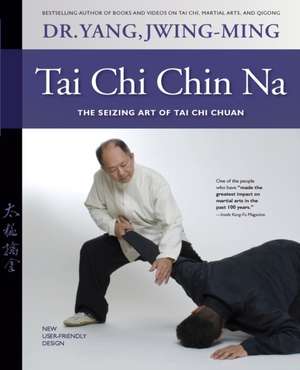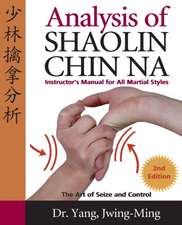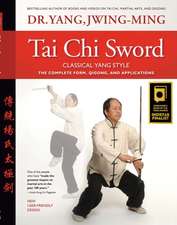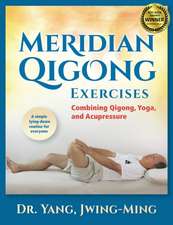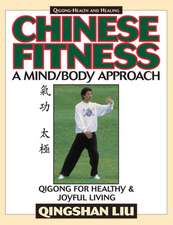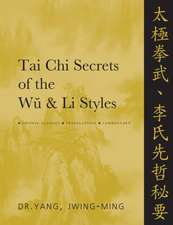Tai Chi Chin Na Revised
Autor Jwing Ming Yangen Limba Engleză Paperback – 7 dec 2014
Chin Na is the art of seizing and controlling, it is a major element of all Chinese martial arts including Tai Chi Chuan.
Today, most people practice Tai Chi Chuan to maintain health or cure sickness. For the last fifty years the martial aspects of Tai Chi Chuan have been ignored, and the art is now incomplete. Most practitioners no longer understand the martial applications of Tai Chi Chuan, or even that it is a martial art. For example, the concept and training methods of Tai Chi Jin (or Tai Chi martial power), and how to apply internal Qi in the martial arts have become an unfamiliar subject in Tai Chi societies today. As a result, actual martial applications of Jin and Qi, such as Chin Na or Cavity Strikes, are currently not popularly known or studied.
To preserve Tai Chi's martial aspect, this book presents numerous Tai Chi Chin Na (Qin Na), the art of controlling an opponent through joint locks and cavity strikes.
Tai Chi Chin Na is one of the four main martial training categories of Tai Chi Chuan (the other three categories are striking, kicking, and wrestling/downing the opponent). Of all these four, Chin Na is the most effective, practical, powerful, and easiest to learn. Once you have mastered Tai Chi Chin Na, you will be able to apply the theory and techniques to any other martial style you practice. If you are a Tai Chi beginner, Tai Chi Chin Na could offer you a key to enter the door of martial Tai Chi.
This book provides a solid and practical approach to learning Tai Chi Chin Na accurately and quickly. You will learn specific techniques that flow from each movement, the proper hand forms to use when striking or pressing cavities, and the locations for targeting cavities on the body. Includes 858 photographs with motion arrows!
- General concepts of Chin Na
- Basic Chin Na theory and training
- 51 Chin Na techniques for peng, lu, ji, and an
- 41 Chin Na techniques for cai, lei, zhou, and kao
- 103 Chin Na applications for the 37 primary Tai Chi postures
- 17 Chin Na techniques for Tai Chi Pushing Hands
No matter your age or martial prowess, Tai Chi Chin Na is a necessary and enjoyable way to explore the depths of Tai Chi?a formidable martial art.
Preț: 154.02 lei
Nou
29.48€ • 32.03$ • 24.78£
Carte disponibilă
Livrare economică 31 martie-14 aprilie
Livrare express 14-20 martie pentru 45.49 lei
Specificații
ISBN-10: 1594393079
Pagini: 336
Ilustrații: 51 black & white illustrations, 858 black & white halftones
Dimensiuni: 181 x 249 x 25 mm
Greutate: 0.86 kg
Ediția:Revised
Editura: TRADE SELECT
Descriere
FINALIST - 2014 FOREWORD'S INDIEFAB AWARDS Seize and Control Skills for Tai Chi Chuan Hundreds of chin na grappling techniques are hidden within tai chi movements. You can achieve these seize and control skills by including Tai Chi Chin Na in your training regimen. Here's your chance to take the next step in your tai chi journey Once you have attained proficiency in the bare hand form and have begun pushing hands, you are ready for tai chi chin na. The effective martial skills of traditional tai chi chuanTai chi chin na will help you include martial art skills in your tai chi training. Chin na, along with punching, kicking, and wrestling, is one of the four categories that are required in a traditional martial arts. This book provides a solid and practical approach to learning tai chi chin na accurately and quickly. You will learn specific techniques that flow from each movement, the proper hand forms to use when striking or pressing cavities, and the locations for targeting cavities on the body. Includes 858 photographs with motion arrows - General concepts of chin na- Basic chin na theory and training- 51 chin na techniques for peng, lu, ji, and an- 41 chin na techniques for cai, lei, zhou, and kao- 103 chin na applications for the 37 primary tai chi postures- 17 chin na techniques for tai chi pushing hands No matter your age or martial prowess, tai chi chin na is a necessary and enjoyable way to explore the depths of tai chi--a formidable martial art.
Cuprins
Foreword by Grandmaster Li, Mao-Ching
Foreword by Grandmaster Jou, Tsung-Hwa
Foreword by Master Liang, Shou-Yu
Preface by Dr. Yang, Jwing-Ming
Chapter 1. General Concepts
1-1. Introduction
1-2. Qin Na Categories and Theory
1-3. Different Levels of Qin Na Techniques
1-4. Qin Na and Health
1-5. Differences between Shaolin Qin Na and Taiji Qin Na
1-6. About This Book
Chapter 2. Basic Taiji Theory
2-1. Introduction 27
2-2. The Three Different Fighting Ranges and Circles
2-3. The Thirteen Postures
2-4. Yi, Qi, and Action
Chapter 3. Qin Na in Peng, Lu, Ji, and An
3-1. Introduction
3-2. Qin Na in Peng
3-3. Qin Na in Lu
3-4. Qin Na in Ji
3-5. Qin Na in An
Chapter 4. Qin Na in Cai, Lie, Zhou, and Kao
4-1. Introduction
4-2. Qin Na in Cai
4-3. Qin Na in Lie
4-4. Qin Na in Zhou
4-5. Qin Na in Kao
Chapter 5: Qin Na Applications in Taijiquan Postures
5-1. Introduction
5-2. Hand Forms for Cavity Press
5-3. Qin Na and Cavity Press in Taiji Postures
Chapter 6. Qin Na in Taiji Pushing Hands
6-1. Introduction
6-2. Qin Na in Taiji Pushing Hands
Chapter 7. Conclusion
Acknowledgements
Appendix A: Names of Qin Na Techniques
Appendix B: Translation of Thirty-Seven Postures
Appendix C: Translation and Glossary of Chinese Terms
Index
About the Author
Notă biografică
Dr. Yang, Jwing-Ming started his Gongfu training at the age of 15 under the Shaolin White Crane Master Cheng, Gin Gsao. Dr. Yang became an expert in the White Crane style of Chinese martial arts. With the same master he also studied Qin Na, Tui Na and Dian Xue massages, and herbal treatment.
At the age of 16, Dr. Yang began the study of Taijiquan under Master Kao, Tao. Dr. Yang's tai chi can be traced back to the Yang family through Master Kao's teacher Yue, Huanzhi, an indoor disciple of Yang, Chengfu.
After learning from Master Kao, Dr. Yang continued his study and research of Taijiquan. Dr. Yang has mastered the Taiji barehand sequence, pushing hands, the two-man fighting sequence, Taiji sword, Taiji saber, and Taiji Qigong.
Dr. Yang has been involved in Chinese Gongfu since 1961. During this time, he has spent 13 years learning Shaolin White Crane, Shaolin Long Fist, and Taijiquan. Dr. Yang has more than thirty years of instructional experience.
